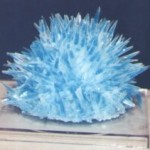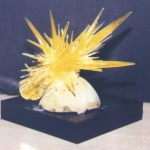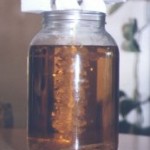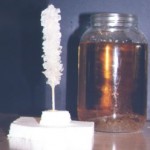Making Rock Candy
Take advantage of the process of crystallization to make candy! You’ll create a super saturated solution of sugar and use it to grow your own homemade sugar candy crystals. (A super saturated solution is one that has as much sugar dissolved in the water as possible. Note- if we didn’t heat the water, we’d wind up with only a saturated solution.)
Boil three cups of water in a large pot on the stove. Add eight cups of sugar, one cup at a time, slowly stirring as you go. The liquid should be thick and yellowish. Turn off the heat and let it sit for four hours (or until the temperature is below 120 degrees F). Pour the sugar water solution into clean glass jars and add a couple drops of food coloring (for colored crystals). Tie a string to a skewer, resting the skewer horizontally across the jar mouth. Let sit for a few weeks to a few months.
What kind of questions can you ask about this project? What happens when you vary the amount of water? Sugar? Time? Seed or not to seed the stick? Does it really matter how warm the environment is? What if you don’t heat the solution to dissolve more? Can you color the crystals? Why does the color stick (or not)? Does salt work instead of sugar? How about epsom salts? Does laundry detergent work, too?
The images below are sugar crystals, ammonia, and copper crystals.
Comments off






